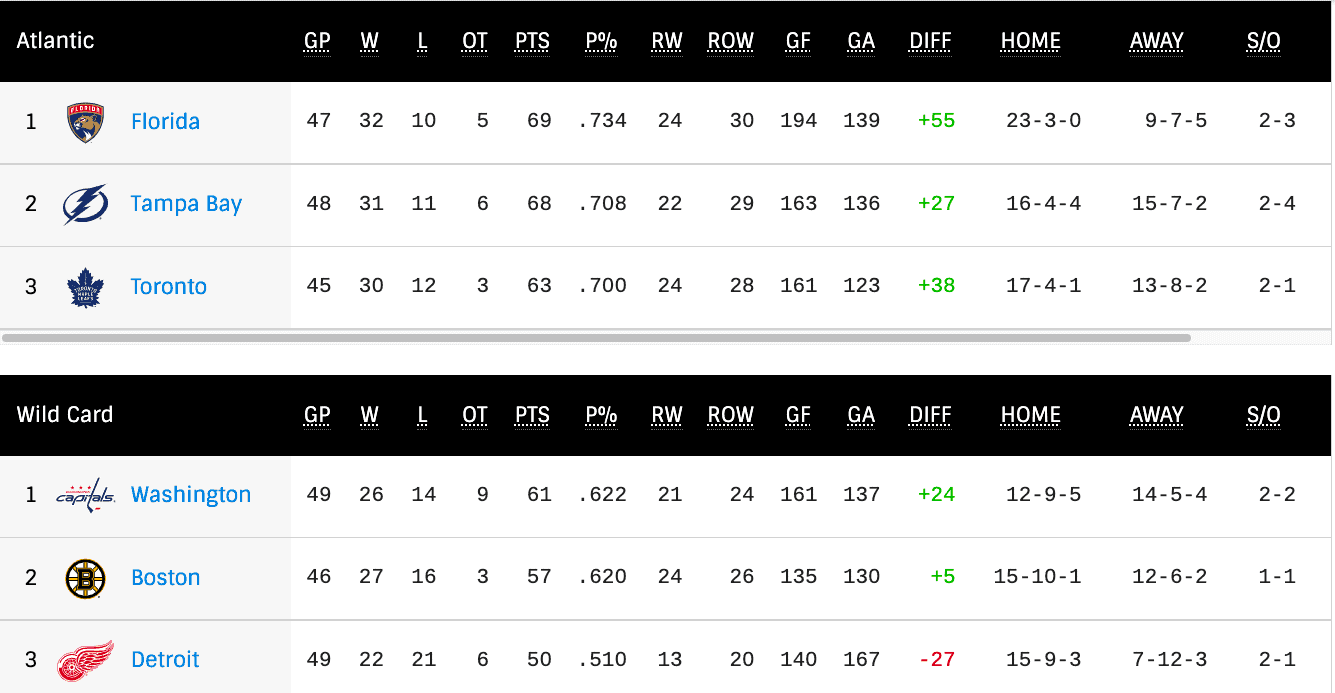If you’re new to the game of hockey, then you’ve probably heard broadcasters throw around the term “Wild Card” here and there.
Is it a poker term? Or something to do with the Vegas Golden Knights?
Is it their team mascot? Is it a special hockey trading card?
Well, actually, the wild card in hockey has to do with the format of the NHL playoffs.
Keep reading to find out exactly what a wild card is and how the playoff format works.
We’ll even go over some real examples of the wild card in action—and a handy tip to determine the odds of any team making it to the playoffs.
Here’s What a Wild Card Is in Hockey:
The NHL playoffs include 16 teams. Each conference sends 8 teams. The top 3 teams from four divisions automatically qualify, filling 12 of 16 spots. The remaining 4 spots (2 from each conference) go to the teams with the most points during the regular season—these are NHL wild cards.

When Was Wild Card Introduced in the NHL?
The Wild Card began in the 2013-14 NHL season. The top three teams from each division advance to the playoffs. The remaining two teams with the most points in each conference are considered “wild cards”.
These wild card teams can come from any division. This means one division in a conference may send 3 teams to the playoffs while the other division could send 5 teams. Or, each division could end up sending 4 teams evenly.
Curious how “points” work when it comes to NHL standings? Check out this post here: What Is a Point in Hockey.
How Many Teams Make the NHL Playoffs 2022?
In 2022, sixteen of the league’s thirty-two teams go on to compete in the postseason in the NHL playoffs.
The Western Conference and Eastern Conference both send half of the teams (8 each).
In each conference, the top three teams from each division, plus the next two best teams (regardless of division) make the playoffs.
This produces 8 first-round matchups.
What Teams Have Clinched a Playoff Spot?
Wondering what teams will make the playoffs?
Playoffstatus.com provides an excellent resource that tracks each team’s probability of making the playoffs.
They also show an up-to-date-number of what the odds are of each team securing the wild card spot in each conference.
You can check out the Western Conference Playoff Probabilities Here.
You can check out the Eastern Conference Playoff Probabilities Here.
When the playoffs start, they will also show you what teams have been eliminated in real time.
This is a great site to track, especially if you plan on buying playoff hockey tickets.
What Is the NHL Playoff Format?
The playoff format consists of 16 of the best 32 NHL teams competing head to head over 4 rounds.
In each round, the top seeded team competes against the lowest seeded team in a best of 7 matchup. The first team to win 4 games wins the series and moves onto the next competitor.
The 7 games are split between each team’s home stadium in this format:
- Game 1: High Seed at Home
- Game 2: High Seed at Home
- Game 3: Low Seed at Home
- Game 4: Low Seed at Home
- Game 5: High Seed at Home
- Game 6: Low Seed at Home
- Game 7: High Seed at Home
This format gives the high seed the home-ice advantage in each series.
During the playoffs, teams compete against competitors in their own conference for the first 3 rounds.
In the fourth round, the two top teams from the Eastern and Western conferences compete against one other in the Stanley Cup Finals. The winner of the series wins the Stanley Cup.
How Many Wild Cards Are There in the NHL?
There are 4 wild cards total in the NHL—2 from each conference.
Both the Western and Eastern Conferences provide 2 wild card teams to the playoffs.
Once the top 3 teams in each of the four divisions secure their position in the playoffs, the remaining 2 spots from each conference are given to the teams with the highest points in the regular season.
What Was the Playoff Format Before the NHL Wild Card?
The league introduced the wild card playoff format in the 2013-14 NHL season.
Before the Wild Card format, the NHL used a different playoff format.
Rather than being split between 2 divisions in each conference (4 total), the NHL had 3 divisions in each conference (6 total).
The three teams in first place in their respective divisions qualified and were selected as the top 3 seeds in the playoffs.
The remaining 5 spots from each conference were chosen from the next top five teams (teams with the most points in the regular season). These 5 teams were then placed in seeds 4 through 8.
In this scenario, you could technically have a postseason where a single division sends 5 teams to the playoffs, while the other two divisions sent only 2 or even 1.
This playoff format was used from the NHL’s 1998-99 to 2012-2013 seasons.
Where Does the Term “Wild Card” Come From?
The term “wild card” in the NHL comes from NFL football.
The concept is that a wild card is the team in a conference that has the best record even though they didn’t finish at the top of their division.
In the NFL, the top team in the division (division winner) is the only one guaranteed a playoff spot.
In the NHL, the top 3 teams in each division (division winners) are guaranteed a playoff spot.
In the NHL, the remaining two spots in each conference are given to four wild card teams. These are the best two remaining teams in each conference—and they’re given the final playoff spots.
In the 2013-2014 season, the NHL adopted the “wild card” system from the NFL for their playoff format.
What Happens if 2 Teams Are Tied for the NHL Wild Card?
There have been a few cases where two teams tie for the NHL wild card position.
This means these two teams have the exact same number of points to claim a wild card position. In this scenario, the NHL will give the wild card spot to one of the teams based on secondary conditions in this order:
1. The Team with the fewer number of games played.
2. The greater number of regulation games won (excluding overtime or shootout wins).
Who Do Wild Card Teams Play Against in the Playoffs?
Of the qualifying teams, the wild card clubs are the lowest ranked going into the playoffs.
Since the NHL uses a seeded playoff format, the top team will play the worst team, and the second best team will play the second worst, and so on.
Here are the seed matchups:
- 1st Seed vs. 8th Seed
- 2nd Seed vs. 7th Seed
- 3rd Seed vs. 6th Seed
- 4th Seed vs. 5th Seed
The wild card teams will always be the 7th and 8th seed going into the playoffs. This means they will always begin round one versus the top two teams.
Here’s a round one results example:
- 1st Seed (winner) vs. 8th Seed
- 2nd Seed vs. 7th Seed (winner)
- 3rd Seed (winner) vs. 6th Seed
- 4th Seed vs. 5th Seed (winner)
After each round, the teams re-seed, meaning the wild card team could play multiple teams if they’re able to win the round.
In this scenario, the teams would be re-seeded.
The second round match ups would look like this:
- 3rd Seed vs. 8th Seed
- 4th Seed vs. 6th Seed
Fun fact:There has only been one 8th seeded team (the worst team) who has won the Stanley Cup. That team was the 2012 Los Angeles Kings.
2019 Wild Card Teams (Real NHL Example)
Let’s take a look at a few real wild card examples using the 2020-21 NHL Season.
Eastern Conference
In the Atlantic Division, the top 3 teams to automatically qualify for the playoffs were:
- Tampa Bay Lightning (128 Points)
- Boston Bruins (107 Points)
- Toronto Maple Leafs (100 Points)
In the Metropolitan Division, the top 3 teams to qualify were:
- Washington Capitals (104 Points)
- New York Islanders (103 Points)
- Pittsburgh Penguins (100 Points)
Those division-leading teams claimed 6 out of 8 spots from the Eastern Conference playoff spots.
The remaining two spots went to the wild card teams.
In 2019, the next two Eastern teams with the highest points were:
- Carolina Hurricanes (99 Points)
- Columbus Blue Jackets (98 Points)
Carolina and Columbus took the wild card spots since they had the highest points of any remaining Eastern Conference teams.
Western Conference
In the Central, the top 3 teams to automatically qualify for the playoffs were:
- Nashville Predators (100 Points)
- Winnipeg Jets (99 Points)
- St. Louis Blues (99 Points)
In the Pacific Division, the top 3 teams to qualify were:
- Calgary Flames (107 Points)
- San Jose Sharks (101 Points)
- Vegas Golden Knights (93 Points)
Those division-leading teams claimed 6 out of 8 spots from the Western Conference playoff spots.
The remaining two spots went to the wild card teams.
In 2019, the next two Western teams with the highest points were:
- Dallas Stars (93 Points)
- Colorado Avalanche (90 Point)
Dallas and Colorado took the Western Conference wild card spots since they had the highest points of any remaining teams in the West.
Current NHL Wild Card Standings
For an up-to-date view of the current wild card standings, you can check out NHL.com’s up-to-date wild card spots.
Scroll to each conference’s “Wild Card” section to see who the top two teams are.
These wild card spots are subject to change up until the playoffs begin or a team has “clinched” a wild card spot.
Looking for more answers to the most common hockey questions? Be sure to check out our other popular blog posts: Is There a Size Limit for Hockey Goalies, Why Is Icing in Hockey Bad, and What’s the Best Height for Ice Hockey!
Sources
https://www.nhl.com/standings/2021/wildcard
